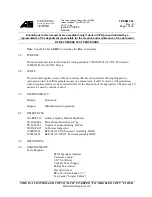
Plant changes in RUN - CiR
11.11 Effects on the process when re-configuring in RUN
CPU 410 Process Automation/CPU 410 SMART
194
System Manual, 05/2017, A5E31622160-AC
Rules for System Modification During Runtime
●
You may only add or remove modules immediately after the last existing module. Always
avoid gaps between modules.
●
In order to replace a module with a module of a different type in an existing CPU
configuration, you must perform at least two downloads to the CPU: First, download the
CPU configuration that no longer contains the modules you are going to remove.
Secondly, download the configuration that contains the new modules.
11.10.4
Modules in ET200iSP Modular Slaves
Principle
When you are planning systems during operation via CiR, you must observe the following
already at the planning stages of the ET200iSP stations:
●
Install the ET200iSP station completely with terminal modules and end module.
●
Equip the ET200iSP from the interface module, starting with the necessary electronics
modules. Equip the remaining slots right up to the end module with the reserve modules.
Rules for System Modification During Runtime
Replace the reserve modules with the intended electronics modules. Start with the first
reserve module that is located on the lowest slot (right next to the last electronics module). In
doing so a gap may appear in each case, i.e. always replace just one reserve module with
the electronics module.
11.11
Effects on the process when re-configuring in RUN
11.11.1
Effects on Operating System Functions During the CiR Synchronization Time
Principle
Operating system function
Effects
Process image update
locked.
The process images of the inputs and outputs are held at
their last value.
User program processing
All priority classes are locked, which means no OBs are
processed. However, all outputs are kept at their current
value.
Any existing interrupt requirements are retained.
Currently occurring interrupts are only received by the CPU
once the SDB evaluation is complete.
















































